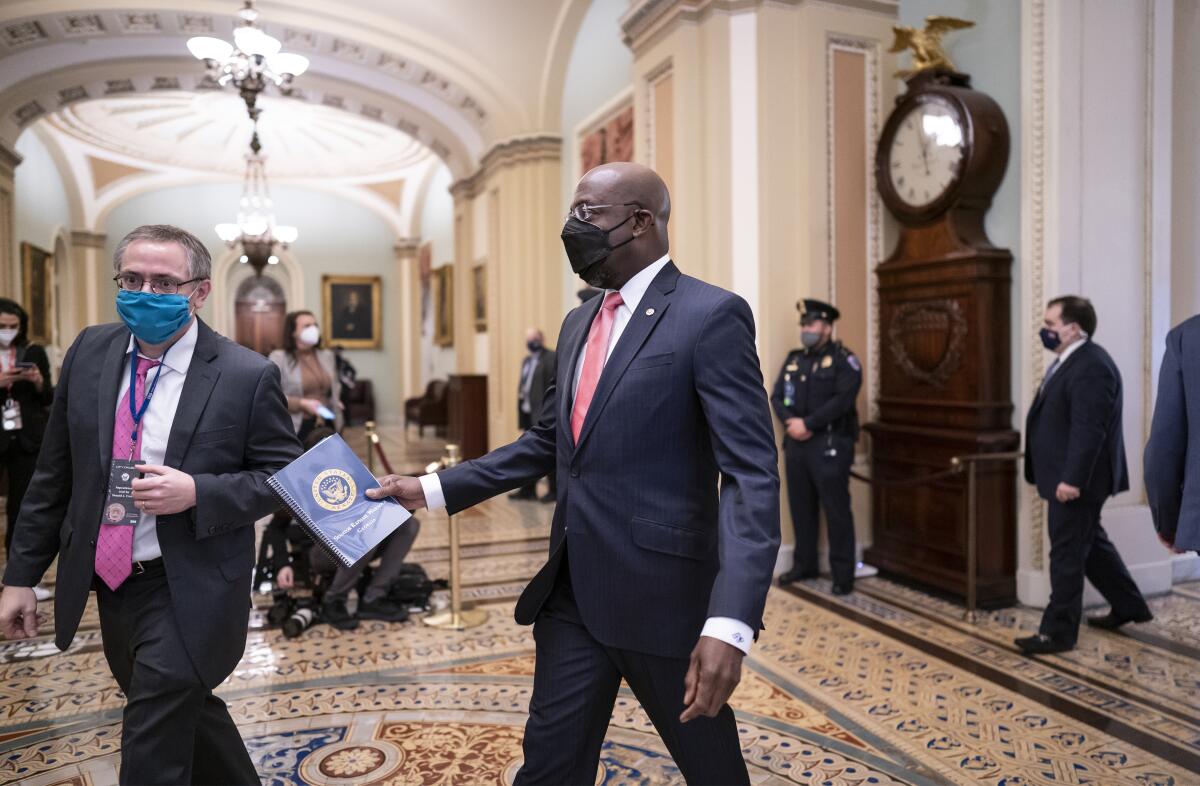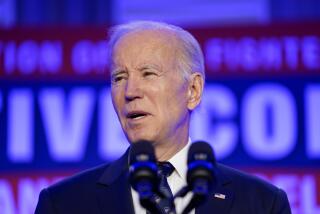Two million poor people were left behind by the ACA. Democrats might finally fix it

- Share via
WASHINGTON — For most of her adult life, Amy Bielawski has gone without health insurance.
Her small Atlanta-area business, which provides entertainment for parties and events, didn’t bring in enough revenue to afford coverage. So she has gotten by on the hope that her high blood pressure doesn’t get worse and her small pituitary tumor doesn’t grow.
“I try to be as healthy as I possibly can so I’m not needing to run to the doctor, but there’s no backup plan when something goes wrong,” she said.
Bielawski, 56, is one of the people the 2010 Affordable Care Act, known as Obamacare, was supposed to help. But the Supreme Court in 2012 said the law’s Medicaid expansion provision had to be optional, and several Republican-led states refused to embrace it.
That left about 2 million people, mostly in Southern states, caught without any access to health coverage because they are considered too wealthy to qualify for Medicaid, which targets lower-income people, and too poor to qualify for Obamacare subsidies. In states like California, which expanded Medicaid under ACA, the gap is not a problem.
As congressional Democrats consider President Biden’s “Build Back Better” plan, a sweeping bill to reshape the nation’s social programs, they are debating whether to finally close this Medicaid coverage gap, the most significant piece of unfinished business from the Democrats’ health law.
But it faces a mountain of challenges: The social safety net bill’s programs will probably be cut or curtailed to reduce the overall costs. Limited healthcare dollars are pitting Medicaid against other proposals to expand Medicare for everyone and ACA subsidies for middle-income people.
Sen. Joe Manchin III (D-W.Va.) says expanding Medicaid would allow for federal funding of abortion, a line he refuses to cross, even though other Democrats say it would not do so. And in the Senate, where Democrats have no margin for error, there are few advocates besides its most junior members.
“There are hundreds of thousands of my constituents who lack basic access to healthcare because my state’s Republican leadership refuses to expand Medicaid,” said Sen. Jon Ossoff (D-Ga.), whose surprise runoff-election win in January, alongside fellow Democrat Sen. Raphael Warnock, gave Democrats control of the Senate. “It is those voters who delivered the Senate majority.”
About 60% of the people in the gap in 2019 were people of color, exacerbating long-held disparities in health access by race.
“Democrats in the House and Senate all realize that solving for the Medicaid expansion gap is the single most important thing we can do for racial equity in healthcare in this bill,” said Leslie Dach, founder and chair of the health advocacy group Protect Our Care.
Early drafts of the bill would call for the ACA’s subsidies to be expanded to the Medicaid gap population for three years. By 2025, a federal program that mimics a state-run Medicaid program would provide coverage.
Manchin, who as the Senate’s most conservative Democrat is among its most closely watched, has two concerns about the Medicaid expansion. He is worried about how to pay for it and he says the Medicaid expansion would allow for the federal funding of abortion.
He insists that the longtime ban on federal funding of abortion, known as the Hyde Amendment, be added. But many other Democrats would oppose such a move. “I do not want to see the Hyde Amendment expanded in this bill, and I don’t see any reason why it should be,” said Sen. Patty Murray (D-Wash.).
Even if they wanted to, the Senate parliamentarian in 2017 said in an informal ruling that the Senate cannot add Hyde language to a bill passed through the special filibuster-proof procedure Democrats are using to enact their plan.
Democrats are adamant they don’t want to see a debate about abortion derail their bill. But federal funding of abortion nearly halted the ACA in 2010 and ended other seemingly bipartisan health initiatives. “There is a supreme irony here. If you’re pro-life, then you ought to support a bill that saves lives,” Warnock said.
Democrats are considering eliminating the second portion of their plan — the federal Medicaid add-on in 2025, according to several Democrats familiar with the discussions. It would reduce the cost as well as eliminate Manchin’s concern. But it would expose Medicaid beneficiaries to losing their coverage in 2025.
Medicaid is also squaring off against two other politically popular health proposals in the bill: expanding either the ACA or Medicare, the healthcare program for seniors.
In recent days, progressives in the Senate and House have made clear that Medicare expansion — to cover vision, dental and hearing — is a non-negotiable for them. And while they haven’t proposed cutting Medicaid, Democrats will at some point have to make difficult decisions about what will get axed. That’s because their once-$3.5 trillion bill is being narrowed down to about $1.5 to $2 trillion to meet the demands of Manchin and other centrists.
A proposal to require drugmakers to negotiate their prices in Medicare — a money-saving plan designed to fund the expansions in new coverage — is expected to be pared down, too, requiring more belt-tightening.
Expanding Medicare benefits would help about 61 million seniors and provide new benefits that would probably be politically popular with reliable voters.
But the optics will be harsh if Democrats provide more benefits to middle-class people through the ACA expansion or people of all income levels — including the wealthy — through an expansion of Medicare benefits, while leaving people who make less than $12,880 per year exposed in the 12 states coping with the gap.
“I think we’ve got to do everything,” Sen. Bernie Sanders (I-Vt.) said when asked whether Medicaid could be left out. “There is a reason why Medicare is an enormously popular program and that is it is effective. It provides care to all of our people. It is universal.”
Several Democrats, particularly in the Senate, have quietly expressed frustration that they will have to spend their already limited dollars to bail out Republican governors who already have access to other federal dollars if they merely overcome their political opposition to Obamacare and choose to expand Medicaid.
Sen. Tammy Baldwin (D-Wis.), whose state didn’t expand, is pitching to fellow Democrats that the Medicaid expansion should be carved out of the price tag since Congress originally approved the funding back in 2010. “This is something that we have already contemplated and set aside funds for and we should look at it in a unique light because of that,” Baldwin said.
Medicaid is a more significant priority in the House than the Senate.
House Majority Whip James E. Clyburn (D-S.C.), whose state is one of those that did not expand, has made Medicaid a priority. Speaker Nancy Pelosi (D-San Francisco) has prioritized beefing up the ACA subsidies as well as Medicaid. Several House Democrats represent districts in states that didn’t expand coverage and they’re pressing their leadership to make sure it stays in the bill.
But in the Senate, there are only three Democrats who represent states that did not choose to expand the program: Baldwin, Ossoff and Warnock — the latter two are the chamber’s two most junior senators.
A few months ago, Bielawski got health insurance for the first time in years and has already been to the doctor. The Democrats’ COVID-19 relief bill, approved in March, provided heavily subsidized ACA coverage to anyone who collected unemployment benefits this year.
She’s said she’s worried about losing it again and troubled by the inequity that leaves people in some states without coverage.
“That seems wrong, doesn’t it,” she said. “There should be some sort of all-country [program.] Some things should be equal.”
More to Read
Get the L.A. Times Politics newsletter
Deeply reported insights into legislation, politics and policy from Sacramento, Washington and beyond. In your inbox three times per week.
You may occasionally receive promotional content from the Los Angeles Times.











